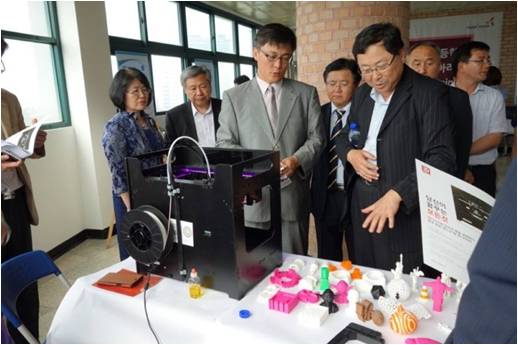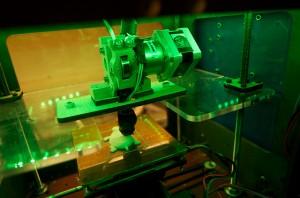If you want to see what it looks like when a country really gets behind 3D printing, then you will want to pay attention to the South Korean government’s newly unveiled initiative. The government has created a 3D Printing Industry Development Council, made up of officials form more than a dozen ministries, and on June 18th they approved the master plan designed to make South Korea a leader in the 3D printing world. Included in the plan are things such as a goal to train 10 million creative makers by 2020 and to expand the 3D printing infrastructure on a national scale. This comes on the heels of an April announcement that the government would be investing $2.3 million dollars in 3D printing equipment and facilities so that companies could run education programs for their employees. All of this continued effort is designed to make South Korea’s 3D printing industry a competitive player in the world market.
So, how do you train 10 million creative makers?
In order to address this tall order, the South Korean government has to put its resources where it’s master plan’s mouth is. In order for this to be more than just wishful thinking, the Council is working to develop detailed curricula to introduce people at all levels to the appropriate 3D technology. As they are interested in integrating the technology across the country, they are creating a variety of levels of education appropriate for elementary school students to adults. Included also is a provision for curriculum development and infrastructure access for digitally underprivileged population.
This ambitious plan also includes creating a society in which access to 3D printing technology is as easy as going to a coffee shop. In this way, the government hopes to move 3D printing from being something that people do in response to a government program to something that is simply another part of their lives. As such, they will be placing 3D printers in approximately 50% of the country’s schools by the year 2017.
 In addition to focusing on education, the plan also addresses the potential that the technology holds for entrepreneurs and business people in the present. As such, the government is coordinating cooperation between software providers, local agencies, and private business to create workshops and introduce 1.5 million business people to the technology.
In addition to focusing on education, the plan also addresses the potential that the technology holds for entrepreneurs and business people in the present. As such, the government is coordinating cooperation between software providers, local agencies, and private business to create workshops and introduce 1.5 million business people to the technology.
The scope of the plan requires an agency such as the national government to coordinate the initiative. Part of the burden that the government is assuming is for the creation of a “National 3D Printing Composite Portal” that it will staff and maintain in order to link the various services and support the movement of information. It will also create a Universal Content Identifier (UCI) system for 3D print data that acts somewhat like the library of congress numbers that identify and distinguish publications. The hope is that in this way information can move freely among users while still maintaining appropriate safeguards for intellectual property.
 This recognition by a national government of the potential that 3D technology has for societal advancement is unprecedented and possibly visionary. Yoon Jong-lok from the ICT ministry spoke in support of the initiative and gave a glimpse into the logic:
This recognition by a national government of the potential that 3D technology has for societal advancement is unprecedented and possibly visionary. Yoon Jong-lok from the ICT ministry spoke in support of the initiative and gave a glimpse into the logic:
“We need to strengthen our ability to prepare for the future knowledge society by forming a creative culture where all the people can demonstrate their creativeness and imaginativeness freely.”
It will be interesting to see if and how the South Korean government manages to fulfill the goals outlined in this master plan. Many questions remain to be answered about control of data, infrastructure management, and logistics but it is inspiring to see such an effort undertaken. It makes you wonder what initiatives like this in other countries around the world could do to advance the field of 3D making. This technology is only going to increase in importance and where there are savings made by not striving to be on the cutting edge they will likely be spent in order to play catch up once they have fallen behind.
Will other countries follow suit? What will this mean for 3D printing in general in Asia? Let us know your opinion in the 3D printing Korean initiative forum at 3DPB.com.
Subscribe to Our Email Newsletter
Stay up-to-date on all the latest news from the 3D printing industry and receive information and offers from third party vendors.
You May Also Like
Gorilla Sports GE’s First 3D Printed Titanium Cast
How do you help a gorilla with a broken arm? Sounds like the start of a bad joke a zookeeper might tell, but it’s an actual dilemma recently faced by...
Nylon 3D Printed Parts Made More Functional with Coatings & Colors
Parts 3D printed from polyamide (PA, Nylon) 12 using powder bed fusion (PBF) are a mainstay in the additive manufacturing (AM) industry. While post-finishing processes have improved the porosity of...
$25M to Back Sintavia’s Largest Expansion of Metal 3D Printing Capacity Since 2019
Sintavia, the digital manufacturing company specializing in mission-critical parts for strategic sectors, announced a $25 million investment to increase its production capacity, the largest expansion to its operations since 2019....
Velo3D Initiates Public Offering in a Bid to Strengthen Financial Foundations and Drive Future Growth
Velo3D (NYSE: VLD) has been among a number of publicly traded 3D printing firms that have attempted to weather the current macroeconomic climate. After posting a challenging financial report for 2023,...
































